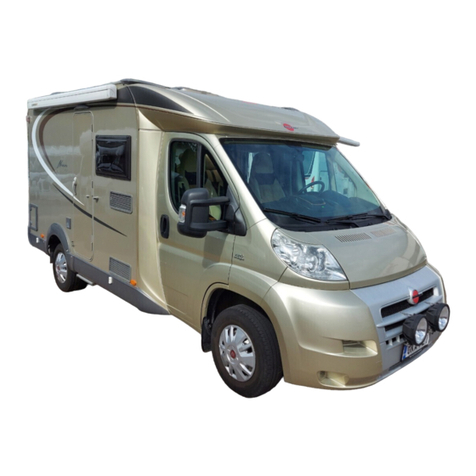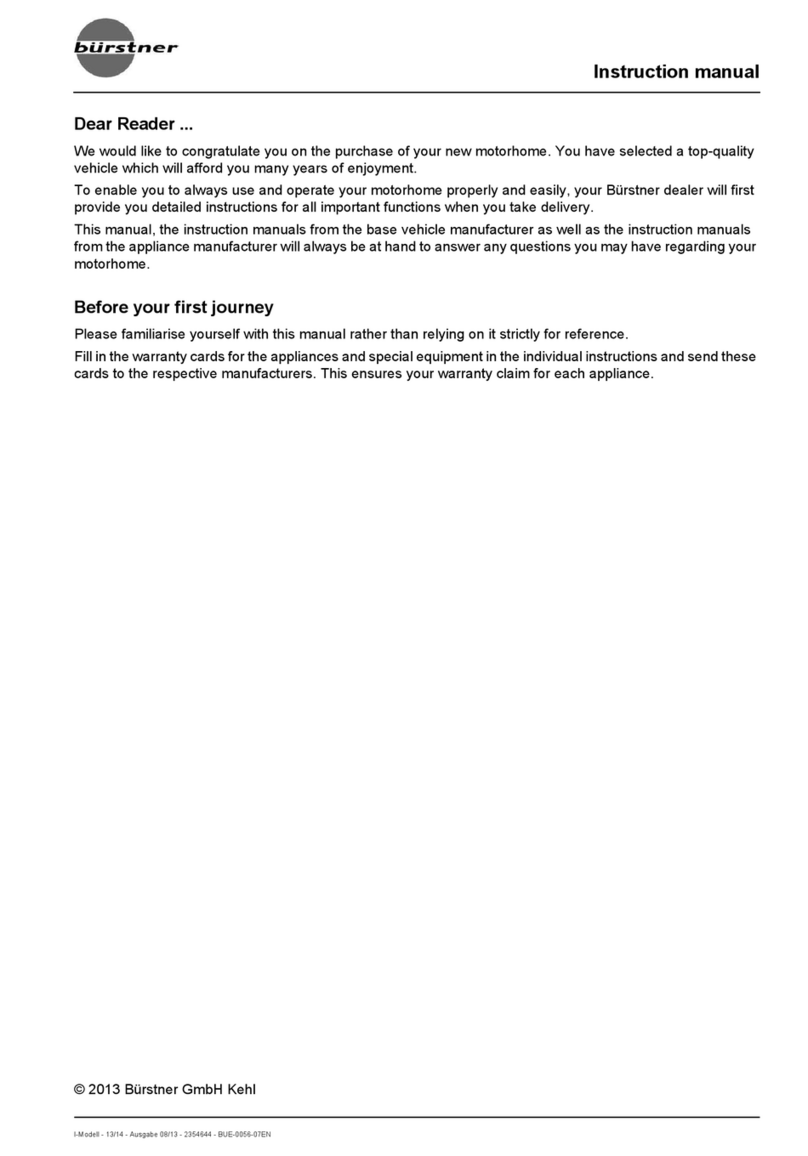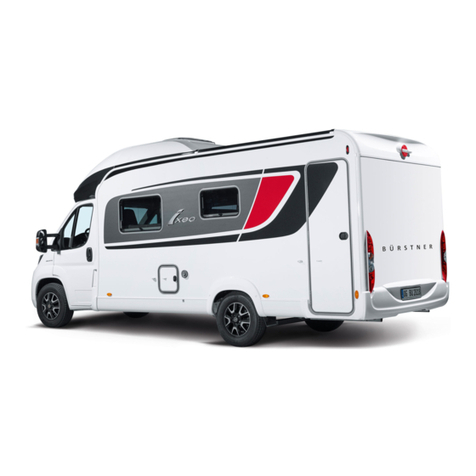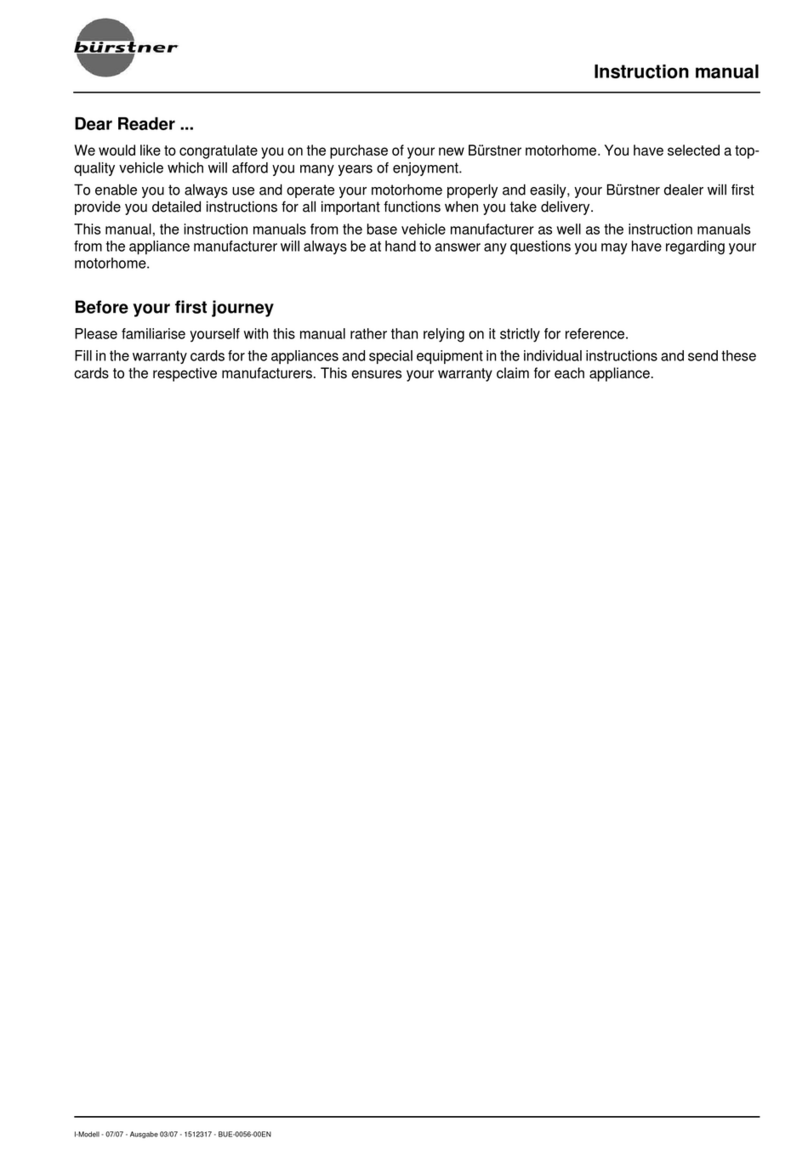
3Belcanto/Trecento - 10/11 - Ausgabe 07/10 - 1976844 - BUE-0042-06EN
1Introduction. . . . . . . . . . . . . . . . . . . 7
1.1 General . . . . . . . . . . . . . . . . . . . . . . . . . 8
1.2 Environmental tips. . . . . . . . . . . . . . . . . 8
2Safety. . . . . . . . . . . . . . . . . . . . . . . . 11
2.1 Fire prevention . . . . . . . . . . . . . . . . . . 11
2.1.1 Avoidance of fire risks . . . . . . . . . . . . . 11
2.1.2 Fire-fighting . . . . . . . . . . . . . . . . . . . . . 11
2.1.3 In case of fire. . . . . . . . . . . . . . . . . . . . 11
2.2 General . . . . . . . . . . . . . . . . . . . . . . . . 12
2.3 Road safety. . . . . . . . . . . . . . . . . . . . . 12
2.4 Towing. . . . . . . . . . . . . . . . . . . . . . . . . 13
2.5 Gas system . . . . . . . . . . . . . . . . . . . . . 14
2.5.1 General instructions . . . . . . . . . . . . . . 14
2.5.2 Gas bottles . . . . . . . . . . . . . . . . . . . . . 15
2.6 Electrical system . . . . . . . . . . . . . . . . . 15
2.7 Water system . . . . . . . . . . . . . . . . . . . 16
3 Before the journey . . . . . . . . . . . 17
3.1 Keys . . . . . . . . . . . . . . . . . . . . . . . . . . 17
3.2 Registration . . . . . . . . . . . . . . . . . . . . . 17
3.3 Connecting . . . . . . . . . . . . . . . . . . . . . 18
3.4 Caravan couplings . . . . . . . . . . . . . . . 19
3.4.1 AKS 1300 stabiliser. . . . . . . . . . . . . . . 19
3.4.2 AKS 3004 stabiliser. . . . . . . . . . . . . . . 19
3.4.3 WS 3000 D stabiliser. . . . . . . . . . . . . . 20
3.5 Hitching device Easy-Pull (special
equipment) . . . . . . . . . . . . . . . . . . . . . 20
3.6 Caravan control system . . . . . . . . . . . 21
3.6.1 Caravan control system (ATC)
(special equipment). . . . . . . . . . . . . . . 21
3.6.2 Caravan control system (IDC)
(special equipment). . . . . . . . . . . . . . . 22
3.7 Detaching . . . . . . . . . . . . . . . . . . . . . . 22
3.8 Payload . . . . . . . . . . . . . . . . . . . . . . . . 23
3.8.1 Terms . . . . . . . . . . . . . . . . . . . . . . . . . 23
3.8.2 Calculating the payload. . . . . . . . . . . . 25
3.8.3 Loading the caravan correctly . . . . . . . 26
3.8.4 Caravan load, nose weight and
axle load . . . . . . . . . . . . . . . . . . . . . . . 27
3.8.5 Bike rack (special equipment) . . . . . . . 28
3.9 External mirrors. . . . . . . . . . . . . . . . . . 30
3.10 Television (special equipment) . . . . . . 31
3.11 Road safety. . . . . . . . . . . . . . . . . . . . . 31
4 During the journey . . . . . . . . . . . 33
4.1 Driving with the caravan . . . . . . . . . . . 33
4.2 Brakes. . . . . . . . . . . . . . . . . . . . . . . . . 33
4.3 Driving in reverse . . . . . . . . . . . . . . . . 33
5 Pitching the caravan . . . . . . . . . 35
5.1 Handbrake. . . . . . . . . . . . . . . . . . . . . . 35
5.2 Wheel chocks . . . . . . . . . . . . . . . . . . . 35
5.3 Corner steadies. . . . . . . . . . . . . . . . . . 35
5.4 Entrance step (free-standing) . . . . . . . 36
5.5 Waste water tank, mobile (special
equipment) . . . . . . . . . . . . . . . . . . . . . 37
5.6 230 V connection . . . . . . . . . . . . . . . . . 37
5.7 Refrigerator . . . . . . . . . . . . . . . . . . . . . 37
5.8 Satellite unit (special equipment) . . . . . 37
5.8.1 Equipment with automatic antenna
alignment . . . . . . . . . . . . . . . . . . . . . . . 37
5.8.2 Equipment with semi-automatic
antenna alignment . . . . . . . . . . . . . . . . 38
6Living. . . . . . . . . . . . . . . . . . . . . . . . 41
6.1 Conversion door . . . . . . . . . . . . . . . . . 41
6.1.1 Conversion door, outside. . . . . . . . . . . 41
6.1.2 Conversion door, inside . . . . . . . . . . . . 42
6.1.3 Window conversion door (Seitz)
(special equipment) . . . . . . . . . . . . . . . 42
6.1.4 Folding insect screen on the
conversion door (special
equipment). . . . . . . . . . . . . . . . . . . . . . 42
6.2 External flaps . . . . . . . . . . . . . . . . . . . . 43
6.2.1 Flap lock, elliptical-shaped. . . . . . . . . . 43
6.2.2 Flap lock, rectangular . . . . . . . . . . . . . 44
6.2.3 Flap for toilet cassette . . . . . . . . . . . . . 45
6.2.4 Flap for the 230 V connection,
square . . . . . . . . . . . . . . . . . . . . . . . . . 45
6.2.5 Cap for the drinking water filler neck
(only for water tank 40 l) . . . . . . . . . . . 46
6.3 Furniture flaps . . . . . . . . . . . . . . . . . . . 46
6.3.1 Furniture flaps with push button. . . . . . 46
6.3.2 Furniture flaps with handle. . . . . . . . . . 47
6.3.3 Furniture flaps with release
handle . . . . . . . . . . . . . . . . . . . . . . . . . 47
6.4 Light switch . . . . . . . . . . . . . . . . . . . . . 48
6.4.1 Entrance area . . . . . . . . . . . . . . . . . . . 48
6.4.2 Interior . . . . . . . . . . . . . . . . . . . . . . . . . 48
6.5 Holder for flat screen . . . . . . . . . . . . . 49
6.5.1 Holder on the column. . . . . . . . . . . . . . 49
6.5.2 Holder in the TV cabinet . . . . . . . . . . . 50
6.6 Heating . . . . . . . . . . . . . . . . . . . . . . . . 50
6.7 Ventilation . . . . . . . . . . . . . . . . . . . . . . 50
6.8 Windows . . . . . . . . . . . . . . . . . . . . . . . 51
6.8.1 Hinged window with rotary hinges . . . . 51
6.8.2 Hinged window with automatic
hinges . . . . . . . . . . . . . . . . . . . . . . . . . 53
6.8.3 Blind and insect screen . . . . . . . . . . . . 54
6.8.4 Roman shade and insect screen
(special equipment) . . . . . . . . . . . . . . . 55
6.9 Skylights . . . . . . . . . . . . . . . . . . . . . . . 55
6.9.1 Heki skylight (mini and midi)
(partially special equipment) . . . . . . . . 56
6.9.2 Heki skylight (partially special
equipment). . . . . . . . . . . . . . . . . . . . . . 57
6.10 Tables . . . . . . . . . . . . . . . . . . . . . . . . . 59
6.10.1 Suspension table with folding leg . . . . 59
6.10.2 Lift-off table, rotatable . . . . . . . . . . . . . 60
6.11 Beds. . . . . . . . . . . . . . . . . . . . . . . . . . . 60
6.11.1 Bunk bed . . . . . . . . . . . . . . . . . . . . . . . 60
6.11.2 Fixed bed (manual setup) . . . . . . . . . . 61
6.11.3 Fixed bed (gas-pressure springs) . . . . 61

































